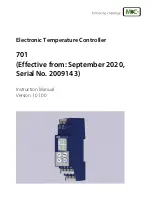
2. Controller Architecture and Program Operation
GEM80-400
Page 2-16
ALSPA GEM80-400 SERIES CONTROLLERS TECHNICAL MANUAL
Issue 3 04/99
2.8.1. Introduction
This section contains only brief details of GEM
80 Ladder Diagram programming
and the subject is dealt with, in detail, in the 'GEM
80 Programming Manual',
Publication No.T391.
2.8.2. Ladder Diagram Language
The controller user program uses the GEM
80 Ladder Diagram Programming
Language which can be illustrated by a simple example:
The circuit for a relay, energised by a push-button, would be represented in GEM
80 Ladder Diagram Programming Language as shown in Figure 2.3. A normally
open push-button or contact is represented by a -] [- symbol and a relay coil by a
-( )- symbol. A0.0 and B1.1 are data table addresses. A0.0 (bit 0 of 16-bit word
A0) is an input data table and stores the state of I/O equipment connected to
the controller relating to address A0.0. B1.1 (bit 1 of 16-bit word B1) is an output
data table and, depending on the result of executing the user program, B1.1 is set
to 1 or 0 and the I/O equipment connected to the controller relating to B1.1 is
controlled by this signal.
This very simple example shows the basic idea of the ladder diagram language.
The instruction set is very large and while it is easy to understand and program in
GEM
80 Ladder Diagram Programming Language, the language is also very
powerful. It offers considerable advantages in simplicity, reliability, flexibility and
power over relay and integrated circuit logic systems for industrial applications.
Figure 2.4 shows two rungs of a ladder diagram program. Each rung is composed
of elements and up to 10 series elements are allowed in each rung. Figure 2.6
also shows that a rung can have several branches. Each rung may have up to 5
parallel branches and up to 20 loops (branch open/branch closed).
Figure 2.3 - Ladder Diagram Language
















































